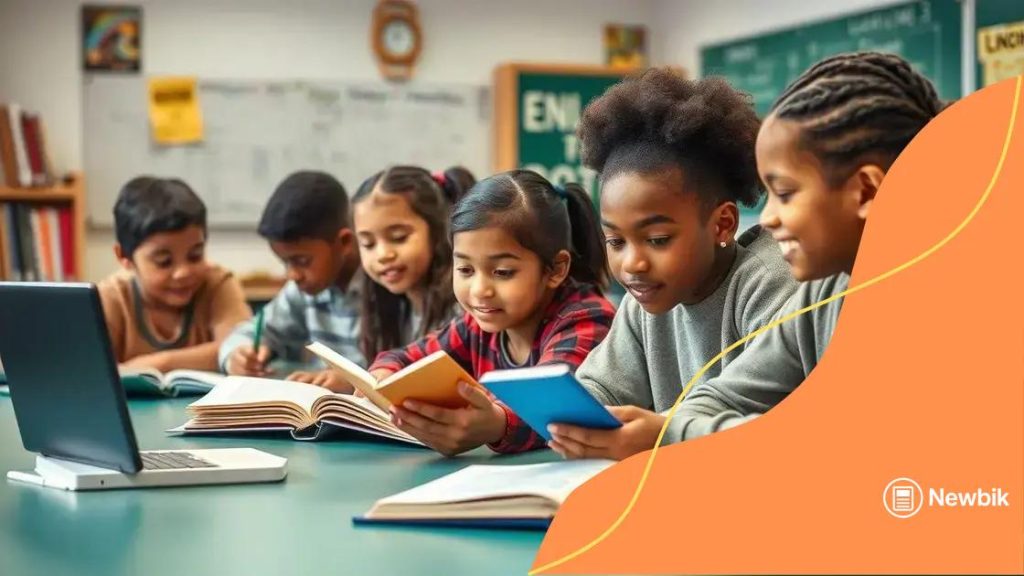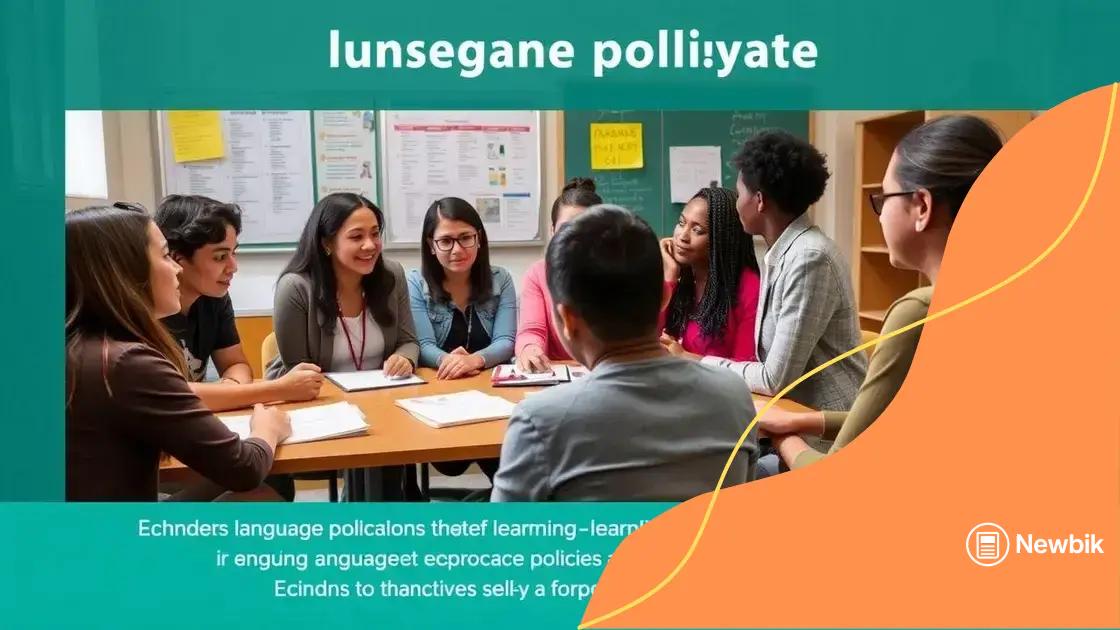Language policy in schools: shaping future generations

Language policy in schools shapes the educational environment by promoting bilingual education, enhancing cultural competence, and incorporating technology to prepare students for a diverse global society.
Language policy in schools is a hot topic today. Have you ever wondered how it shapes our children’s understanding of culture and communication? Join me as we dive into this important discussion.
Understanding language policy in educational settings
Understanding language policy in educational settings is crucial for fostering effective communication and cultural appreciation. It outlines how languages are taught, used, and valued within schools. This policy helps shape students’ experiences and can have a lasting impact on their academic success and social interactions.
The Role of Language Policy
Language policies in education dictate how different languages are integrated into curricula. They ensure that all students have access to language learning opportunities, which can enhance cognitive and social skills. A well-defined policy promotes bilingualism and prepares students for a globalized world. These policies might include:
- Instructions for teaching various languages.
- Guidelines for assessing language proficiency.
- Support for non-native speakers.
- Promotion of cultural understanding through language learning.
Such policies also support students in developing cultural competence, enabling them to engage with diverse perspectives. When schools prioritize a comprehensive language policy, they create environments where students feel valued and understood.
Challenges Faced by Educators
Despite the benefits, implementing effective language policies comes with challenges. Educators often need to balance the demands of curriculum standards with the linguistic needs of their students. Limited resources, such as trained personnel and materials, can hinder effective language instruction. Furthermore, resistance to change can arise from both educators and parents.
Students coming from multilingual homes may also encounter difficulties, especially if the school’s language policies favor a dominant language. Schools must carefully consider how to bridge these gaps to ensure that all learners feel included and supported. Creating a supportive environment requires ongoing training for educators and collaboration among staff.
In conclusion, understanding how language policies impact educational settings is essential for creating inclusive classrooms. By prioritizing effective communication practices, schools can foster environments that celebrate language diversity. Ultimately, this leads to enriched academic experiences for all students.
The importance of bilingual education
Bilingual education is vital in today’s interconnected world. It empowers students to become proficient in more than one language, which enhances their communication skills. A solid foundation in multiple languages promotes cognitive flexibility and cultural awareness.
Benefits of Bilingual Education
Engaging in bilingual education offers various benefits, including:
- Improved academic performance across subjects.
- Enhanced problem-solving skills.
- Increased employability in diverse job markets.
- Stronger social and cultural connections.
These advantages support a well-rounded education and prepare students for future challenges. For instance, studies show that bilingual individuals often excel in critical thinking and creativity.
Cultural Awareness and Empathy
Students in bilingual programs not only learn languages but also gain insights into different cultures. This exposure fosters understanding and empathy towards others. When children learn about various traditions and practices, they develop respect for different perspectives.
Moreover, bilingual education helps students maintain their linguistic heritage. This connection to their roots enriches their identities and promotes community involvement. By valuing all languages in the classroom, educators contribute to a more inclusive educational atmosphere.
The importance of bilingual education cannot be overstated. It equips students with essential skills for personal and professional success while cultivating a sense of global citizenship. With the world becoming increasingly diverse, mastering multiple languages is a valuable asset.
Challenges in implementing language policies

Implementing effective language policies in schools presents several challenges that can hinder the educational experience. These issues arise from various sources, including administrative decisions, resource limitations, and community perceptions. Understanding these challenges is vital for educators and policymakers.
Resource Limitations
One significant challenge is the shortage of resources. Schools often lack adequate funding to develop or support robust language programs. This can affect everything from hiring qualified teachers to providing necessary materials. Without access to proper resources, it becomes difficult to implement a successful language policy.
- Limited instructional materials for different languages.
- Insufficient training for teachers in language education.
- Inadequate technology to support language learning.
- Challenges in maintaining bilingual programs due to financial constraints.
As a result, schools may struggle to meet developmental goals for all students, particularly those who are non-native speakers.
Community and Cultural Resistance
Another challenge is the potential resistance from communities and parents. Some stakeholders may fear that promoting multiple languages may undermine their cultural identity. This resistance can lead to disagreements about the value of bilingual education. Educators must navigate these concerns while promoting the benefits of cultural diversity.
Effective communication is key to addressing these fears. Schools can hold workshops and meetings to educate parents about the advantages of robust language policies. Fostering community involvement can help build trust and support for bilingual initiatives.
Overall, the challenges in implementing language policies are significant but not insurmountable. By addressing resource limitations and community concerns, schools can create supportive environments for language learning that benefit all students.
Impact of language policy on cultural identity
The impact of language policy on cultural identity is profound. Language is more than just a means of communication; it shapes the way individuals perceive themselves and their place in society. As schools implement language policies, they influence how cultural values are transmitted and preserved.
Connection Between Language and Culture
Language embodies cultural beliefs, practices, and traditions. When educational institutions prioritize certain languages, they can inadvertently elevate the culture associated with that language. This can lead to:
- A stronger sense of belonging among speakers of the promoted language.
- The risk of cultural erosion for speakers of minority languages.
- Greater opportunities for cultural expression through language.
- A more diverse cultural landscape in the classroom.
Thus, language policies play a crucial role in either supporting or undermining cultural identities.
Cultural Preservation Through Bilingual Education
Bilingual education acts as a bridge between languages and their corresponding cultures. By incorporating multiple languages in the curriculum, schools allow students to maintain connections to their heritage. This approach encourages pride in cultural identity and fosters respect for diversity.
Students learn more than just vocabulary and grammar; they engage with stories, traditions, and perspectives that enrich their education. As a result, they develop empathy and understanding towards others, shaping a community that values cultural differences.
Policies that support bilingual programs can help combat cultural homogenization, where dominant cultures overshadow minority ones. By celebrating various languages, schools promote inclusivity and mutual respect.
The impact of language policy on cultural identity is significant, as it shapes not just individual identities but also the social fabric of communities. By valuing linguistic diversity, institutions can create environments that honor and uphold a rich tapestry of cultural narratives.
Future trends in language policy in schools
The future of language policy in schools is poised for exciting developments. As the world becomes more interconnected, educational institutions are recognizing the importance of fostering multilingual environments. This will lead to significant changes in how languages are taught and valued in classrooms.
Technological Integration
One prominent trend is the increased use of technology in language education. Digital tools, such as apps and online platforms, enable more interactive and personalized learning experiences. These tools allow students to practice languages in engaging ways, making learning accessible outside of the traditional classroom setting.
- Use of language learning applications.
- Online language exchange platforms to connect students globally.
- Incorporation of virtual reality to simulate language immersion.
- Access to online resources for diverse language options.
As technology becomes more integrated, schools can enhance the language learning experience and better prepare students for a globalized future.
Emphasis on Cultural Competence
Another emerging trend is the emphasis on cultural competence. Schools are recognizing that language education is not just about vocabulary and grammar; it also involves understanding different cultures. This holistic approach helps students gain insight into the communities that speak the languages they are learning, fostering respect and appreciation for diversity.
Programs that include cultural components can help students build empathy and strengthen their identity. By incorporating cultural education, schools prepare students to thrive in diverse environments, both socially and professionally.
The focus on cultural competence will likely grow, leading to more comprehensive language policies that include various cultural perspectives and practices. As these trends evolve, they will contribute to a more inclusive and effective language education system.
Ultimately, the future of language policy in schools will be shaped by innovation and a commitment to diversity. By embracing new technologies and cultural insights, educational institutions can provide students with the skills they need for the challenges of tomorrow.
FAQ – Frequently Asked Questions about Language Policy in Schools
Why are language policies important in schools?
Language policies are essential as they help shape the learning environment and ensure that all students receive equal opportunities to learn and embrace multiple languages.
What are the benefits of bilingual education?
Bilingual education enhances cognitive skills, improves academic performance, and fosters cultural understanding among students, preparing them for a globalized world.
How does technology influence language education?
Technology makes language learning more interactive and engaging through applications and online resources, helping students practice languages effectively.
What is cultural competence in language policy?
Cultural competence refers to the understanding and respect for different cultures and languages, which is crucial for creating an inclusive and empathetic learning environment.